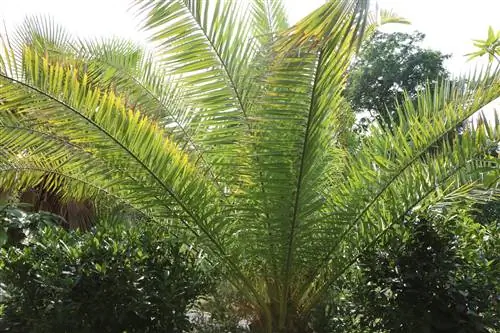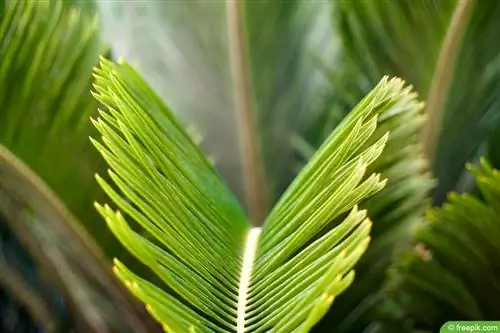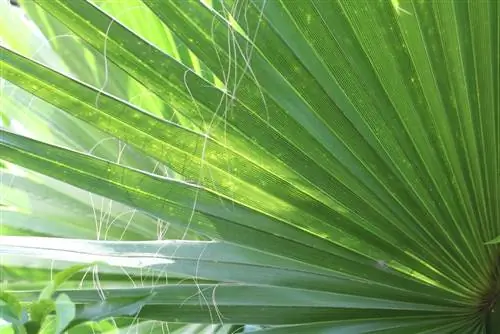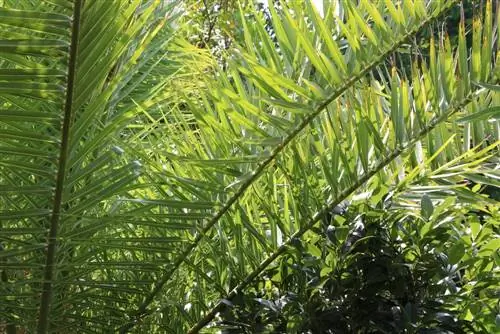- Author admin [email protected].
- Public 2023-12-17 03:39.
- Last modified 2025-01-24 12:45.
The Phoenix palm (Phoenix canariensis) is also known as the date palm and is the least demanding palm among the palm trees. It is content with very little light, preferring a shady location on a terrace or outdoor area during the summer weeks, for example. The phoenix palm has its origins in the Canary Islands and reaches a height of over 20 meters. In the local climate, however, it rarely reaches more than 1.5 meters in height.
In its Canary Islands homeland, the phoenix palm often has flower clusters on the corners of its leaves. These have no scent and their fruits are inedible. In the local climate it rarely reaches more than 1.5 meters in height and it takes a “green thumb” or real luck for this palm to bloom in our latitudes.
There are approximately 13 species of phoenix palms. Of these, only two are suitable for keeping as houseplants. This includes, on the one hand, the “real date palm” (Phoenix dactylifera), which requires a slightly warmer location than the Canary Island variety to overwinter. On the other hand, it is the “swamp date palm” (Phoenix roebelenii), which has its origins in Indochina. It has a more delicate and finer growth and requires increased humidity and a lot of warmth throughout the year (ideally in the winter garden).
Care and location
Young palm plants of this species should
- basically stand in shady places
- Older palm trees can also be placed in sunny places after an extended adjustment period
- they tolerate very high summer temperatures and thank their sunny location for their lush growth
- the phoenix palm must be pampered with softened and tempered water several times within a week
- In the period between April and September it ideally receives fertilizer approximately every 14 days.
Is the palm tree outdoors in the summer weeks
- it should only be placed in the house shortly before the frost period (if the temperature drops to 2 to 3 °C)
- Temperatures between 4 and 8 °C are sufficient in its wintering quarters, although it only requires very little water
- However, if it is much warmer and bright, it requires regular watering
- If the phoenix palm is kept too warm in winter, scale insects can appear.
Approximately every third year the palm tree is repotted during spring
- April is particularly suitable for this, as it is already light and the temperature is rising
- If the phoenix palm has outgrown its planter in late summer or the roots are already growing out of the pot hole, it can of course be repotted
- Higher planters are more suitable for this type of palm
- With an older palm tree, the roots can be cut back by about 1/4, which limits or controls their growth.
Propagation
Propagate the phoenix palm using seeds is easy and common. The seeds require soil, which consists of a combination of peat litter, sand and regular potting soil. The germination container should be at a temperature between 20 to 24 °C. The soil must be kept well moist. After about 4 to 6 weeks the first leaves will appear.
These first cotyledons do not divide. They can be cut off when more fronds have appeared and divided. So when the first cotyledons appear, it is time to place the young plants in individual planters. Care must be taken to ensure that the original seed is not removed under any circumstances. Once a few months have passed, the palm tree is transplanted again into powerful soil and larger planters.
Older phoenix palms sometimes show root shoots. These can be carefully removed and placed individually in a planter. Phoenix palms grow very old with optimal care, especially if they are kept in sufficiently large pots in the winter garden.
Plant Doctor
Brown leaves and wilted leaf edges are usually caused by overwatering, extreme drying out or overfertilization. In this case, the damaged areas and leaves must be completely removed. The phoenix palm must now receive exactly the opposite care from the previous care!
New, undeveloped leaves often look wilted and ugly because they are covered with a brown raffia coating. This appearance is normal for a palm tree of this species and is not a disease. Thin and long palm fronds, on the other hand, are a sign of a lack of light. A stay on the terrace or balcony in summer can do wonders. Round, brown spots on the tips of the leaves can be caused by a fungal disease. However, a fungicide should be sprayed several times every 8 days.
Mealybugs and scale insects can infest even the most resilient phoenix palms. This pest can be scraped off using a knife. The affected leaves are then rubbed with a cotton ball that has been soaked in spirit. Spraying a soft soap solution can help against annoying aphids.
cultivation
If you have time and patience, you can grow your own palm tree from seeds. The kernels should first be soaked in water (two days) and then placed in a shallow bowl in sandy sowing soil and cover everything. The container needs a warm location; the soil temperature should be around 25 degrees. The germination period can be two to three months. First a cotyledon appears. Only when the second leaf appears, remove the cover and carefully repot. To be on the safe side, you can put a bag over it. When the third sheet hits the top of the bag, take it off. Now the plant has enough strength. Normal palm soil, which is available commercially, is suitable as soil.
Location, water & fertilizer
Date palms need a sunny to partially shaded location and high humidity. The north window is not suitable. From March to September you have to provide the plants with enough water. They tolerate hard water poorly. It is recommended to add special fertilizer once a week. The palm tree likes it if you wipe its fronds with a damp cloth every now and then.
In winter, water moderately to lightly, but the soil must not dry out. There is no fertilization. Younger plants are repotted every two to three years, older plants every four years. If you don't want the palm tree to grow any longer, you can cut back the roots a little. It is important to note that little watering is done for two weeks.
Phoenix palms grow very well in hydroponics.






